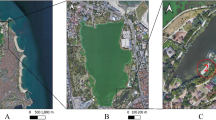Abstract
We present information on an aniline dye marking method for black flies. In the laboratory, adults were sprayed with 2% aqueous solutions of four colors of aniline dyes; brilliant blue and methyl orange gave the best results in longevity trials. In field trials we were able to recapture 1.3% of newly emerged marked and released flies at oviposition sites. Mark–release–recapture experiments were designed to distinguish among three competing models concerning oviposition site selection by gravid female black flies: (1) larval site fidelity (“Do flies return to the site that they experienced as larvae?”), (2) adult site fidelity (“Do flies return to the site that they experienced as adults?”), and (3) no site fidelity (“Do flies oviposit at random, i.e., without regard to adult or larval experience?”). Models 1 and 2 were rejected. There is, however, no reason to reject Model 3, the no site fidelity model. Thus, we conclude that for members of the S. venustum/verecundum complex (i.e., S. rostratum, S. venustum, and S. truncatum) females find an “apparently suitable” waterway in which to oviposit; this may or may not be their natal site.
Similar content being viewed by others
REFERENCES
Baldwin, W. F., Allen, J. R., and Slater, N. S. (1966). A practical field method for recovery of black flies labeled with phosphorous-32. Nature 212: 959-960.
Baldwin, W. F., Gomery, J., and West, A. S. (1975). Dispersal patterns of black flies (Diptera: Simuliidae) tagged with 32P. Can. Entomol. 107: 113-118.
Bennett, G. F. (1963). Use of 32P in the study of a population of Simulium rugglesi (Diptera: Simuliidae) in Algonquin Park, Ontario. Can. J. Zool. 41: 831-840.
Bennett, G. F., and Fallis, A. M. (1971). Flight range, longevity, and habitat preference of female Simulium euryadminiculum Davies (Diptera: Simuliidae). Can. J. Zool. 49: 1203-1207.
Crosskey, R.W. (1990). The Natural History of Blackflies, John Wiley & Sons, British Museum.
Davies, D. M., Peterson, B. V., and Wood, D. M. (1962). The black flies (Diptera: Simuliidae) of Ontario. Part I. Adult identification and distributions of six new species. Proc. Entomol. Soc. Ontario 92: 70-154.
Fallis, A. M. (1964). Feeding and related behaviour of female Simuliidae (Diptera). Exp. Parasitol. 15: 439-470.
Fredeen, F. J. H., Spinks, J. W. T., Anderson, J. R., Arnason, A. P., and Rempel, J. G. (1953). Mass tagging of black flies (Diptera: Simuliidae) with radiophosphorus. Can. J. Zool. 31: 1-15.
Geiger, J. C., Purdy, W. C., and Tarbet, R. E. (1919). Effective malaria control in a ricefield district, with observations on experimental mosquito flights. JAMA 72: 844-847.
Ghent, A. W. (1972). A method of exact testing of 2 x 2, 2 x 3, 3 x 3, and other contingency tables, employing binomial coefficients. Am. Midland Nat. 88: 15-27.
Golini, V. I., and Davies, D. M. (1975). Relative response to coloured substrates by ovipositing black flies (Diptera: Simuliidae). I. Oviposition by Simulium (Simulium) verecundum Stone and Jamnback. Can. J. Zool. 53: 521-535.
Grenier, P. (1949). Contribution à l'étude biologique des Simuliides de France. Physiol. Comp. Oecol. 1: 165-330.
Hunter, F. F., Burgin, S.G., and Wood, D. M. (1994). New techniques for rearing black flies from pupae (Diptera: Simuliidae). J. Am. Mosquito Control Assoc. 10(3): 456-459.
Mitrokhin, V. U. (1973). Oviposition of black flies (Fam. Simuliidae) in northern Transural. Parazitologya 7: 87-88 (trans. from Russian).
Rempel, J. G., and Arnason, A. P. (1947). An account of three successive outbreaks of the black fly, Simulium arcticum, a serious livestock pest in Saskatchewan. Sci. Agr. 27: 428-445.
Rothfels, K. (1981). Cytological approaches to the study of black fly systematics and evolution. In Stock, M. W. (ed.), Applications of Genetics and Cytology in Insect Systematics and Evolution, University of Idaho, Moscow, pp. 67-83.
Service, M. W. (1976). Mosquito Ecology: Field Sampling Methods, Applied Science, London.
Author information
Authors and Affiliations
Rights and permissions
About this article
Cite this article
Hunter, F.F., Jain, H. Do Gravid Black Flies (Diptera: Simuliidae) Oviposit at Their Natal Site?. Journal of Insect Behavior 13, 585–595 (2000). https://doi.org/10.1023/A:1007871820796
Issue Date:
DOI: https://doi.org/10.1023/A:1007871820796




